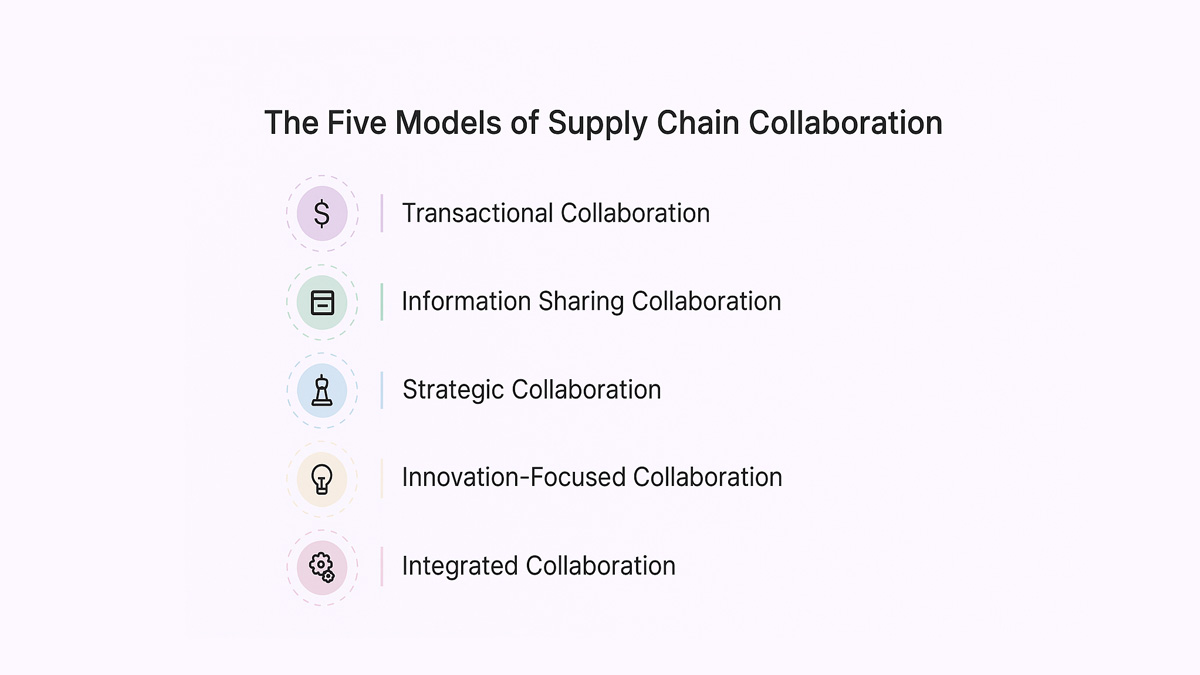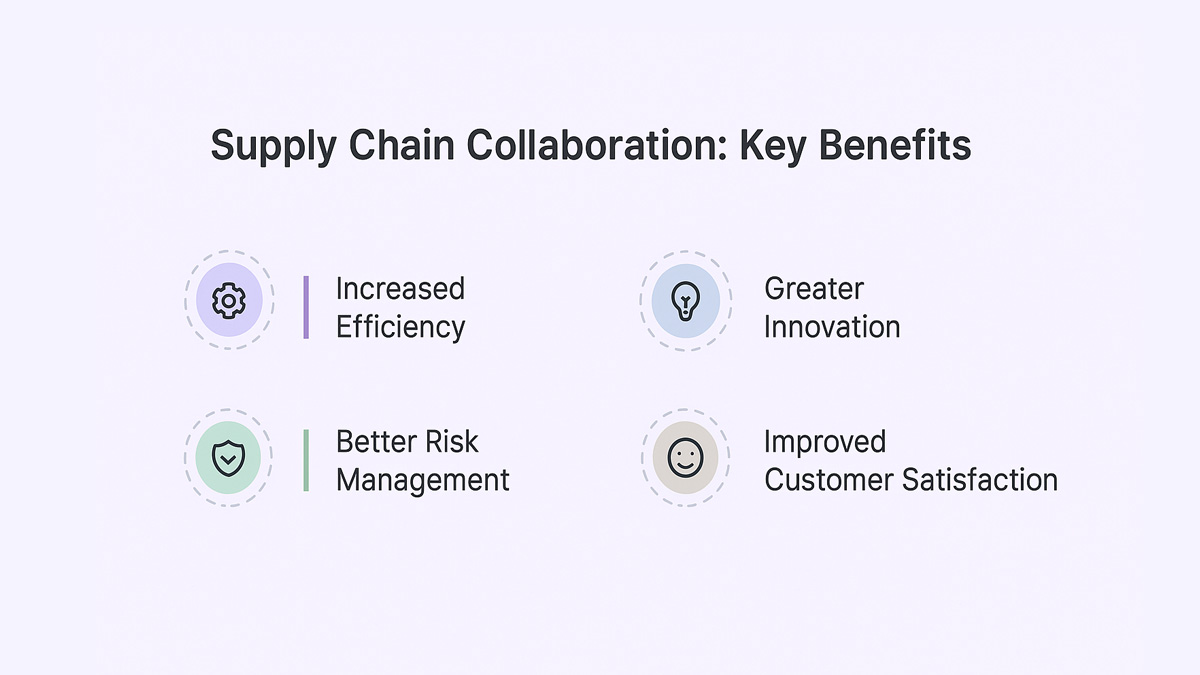

A Complete Guide to Supply Chain Collaboration in 2025

A Complete Guide to Supply Chain Collaboration in 2025
Learn how supply chain collaboration helps businesses boost agility, reduce costs, and build stronger vendor partnerships in 2025.


Imagine your entire supply chain working like a well-rehearsed orchestra - every section in sync, every note timed to perfection. That’s the promise of true collaboration across the supply chain. As businesses face unpredictable demand, global disruptions, and rising customer expectations, aligning with suppliers, partners, and logistics providers isn’t optional anymore - it’s the edge that separates thriving companies from the rest.
What this blog covers:
- What is supply chain collaboration
- Types of supply chain collaboration
- Why supply chain collaboration is important
- Benefits of supply chain collaboration
- Key challenges in supply chain collaboration
- Strategies to improve supply chain collaboration
- Future trends in supply chain collaboration
- How Spendflo helps with supply chain collaboration
- Frequently asked questions on supply chain collaboration
What is Supply Chain Collaboration?
Supply chain collaboration is the strategic alignment and coordination between various stakeholders - suppliers, manufacturers, logistics partners, and retailers - to achieve shared goals such as reducing costs, improving service levels, and responding faster to market changes. By sharing data, insights, and responsibilities, organizations can work together more efficiently and adapt to disruptions with greater agility.
Types Of Supply Chain Collaboration
Supply chain collaboration isn’t one-size-fits-all. Depending on the nature of the relationship and business goals, organizations adopt different models of working together. Collaboration plays a critical role in improving overall supply chain management efficiency and visibility. Each type has its own depth, structure, and expectations.
Here are some common types of supply chain collaboration:

Transactional Collaboration
This is the most basic level, where parties share essential data like inventory levels or delivery schedules. The goal is smooth execution of routine tasks - think EDI (electronic data interchange) for purchase orders or automated invoicing.
Information Sharing Collaboration
At this level, partners go beyond transactions. They share sales forecasts, production plans, and market trends. It builds transparency, helps reduce the bullwhip effect, and improves responsiveness across the chain.
Strategic Collaboration
This involves jointly planning and executing supply chain strategies. Businesses work together on product launches, capacity planning, or inventory management. It often requires co-investment, shared KPIs, and long-term commitment.
Innovation-Focused Collaboration
Some partnerships aim to co-create value through innovation. This could involve collaborating on R&D, sustainable packaging, or last-mile delivery tech. These relationships are typically high-trust, with shared intellectual property rights or joint go-to-market strategies. In regulated industries, supplier certifications can be a foundation for initiating high-level collaboration.
Integrated Collaboration
Here, systems and processes are deeply connected - sometimes even physically colocated. This level of collaboration may include vendor-managed inventory (VMI), shared logistics hubs, or cloud-based platforms that provide real-time visibility across the supply chain.
Each type serves different business needs, and often, companies use a mix depending on the partner and situation. The right mix depends on how well your supply network relationships are structured.
Why Supply Chain Collaboration Is Important
When companies collaborate effectively, they can anticipate disruptions, respond faster, and deliver better outcomes - for both the business and the customer. Here’s why collaboration matters now more than ever:
Improves Communication Across Stakeholders
Collaboration ensures that everyone - from procurement teams to logistics providers - operates from the same page. Real-time data sharing eliminates miscommunications and helps prevent costly mistakes.
Enables Better Demand Planning
By exchanging forecasts and sales trends, companies can improve planning accuracy. Accurate demand forecasting is often a direct outcome of deeper collaboration between supply chain partners. This reduces stockouts, overproduction, and last-minute freight charges.

Increased Efficiency
Shared visibility means fewer blind spots. When partners can see inventory levels, order statuses, and forecasts in real-time, they can coordinate better - reducing redundancies, manual follow-ups, and costly delays.
Better Risk Management
Supply chains today are vulnerable to everything from geopolitical tensions to raw material shortages. Collaborative relationships allow for early warning systems and joint contingency planning, making it easier to mitigate risks before they snowball. Teams that engage in shared scenario planning can respond more effectively to disruptions.
Greater Innovation
Suppliers and logistics providers often hold valuable insights. Supplier collaboration helps uncover these insights earlier in the product lifecycle. By opening up channels for joint brainstorming and feedback, companies can co-develop new packaging, eco-friendly solutions, or even explore new markets together.
Improved Customer Satisfaction
When the back end runs smoothly, the customer feels it. Better collaboration leads to more accurate deliveries, faster turnaround times, and fewer order issues - all of which build loyalty and trust.
Key Challenges In Supply Chain Collaboration
Collaboration sounds ideal, but it’s not always easy to pull off. Many companies struggle to make it work consistently across partners. Here are some common hurdles that get in the way:
Data Silos and Integration Gaps
If each partner operates on different systems, getting a unified view of operations becomes nearly impossible. Lack of system integration limits real-time decision-making and adds to manual effort.
Lack of Trust Between Partners
Collaboration requires openness, but companies may be hesitant to share sensitive data - like pricing, inventory levels, or demand forecasts - fearing it could be used against them in future negotiations.
Misaligned Goals and KPIs
One company’s priority might be reducing cost, while another wants to maximize delivery speed. Over-reliance on a single supplier can strain such partnerships and increase risk exposure. Without shared success metrics, partners often pull in different directions, leading to friction and missed opportunities.
Resistance to Change
Implementing collaborative practices means shifting from old habits - both technologically and culturally. Teams accustomed to working in silos may resist process changes, new platforms, or external input.
Strategies To Improve Supply Chain Collaboration
Strong collaboration doesn’t just happen - it has to be built intentionally. The right strategies can turn scattered, transactional relationships into connected, value-generating partnerships. Establishing a robust collaboration framework ensures structure and accountability. Here’s how to make that leap:
Leverage Technology and Tools
Cloud-based supply chain platforms, shared dashboards, and real-time inventory systems allow all parties to stay informed and aligned. Features like real-time tracking further improve visibility and responsiveness across partners. These tools make it easier to coordinate activities, track shipments, and avoid surprises.
Establish Clear Communication Channels
Set expectations around how, when, and where communication happens. Regular check-ins, shared Slack channels, or even a joint escalation protocol can go a long way in avoiding misunderstandings. Digital collaboration tools make it easier to maintain alignment and resolve issues quickly.
Align on Shared Objectives
Start every partnership by defining mutual goals - whether that’s reducing lead times, improving fill rates, or launching a product faster. These shared goals often feed into broader supply chain planning strategies. Shared KPIs create accountability and ensure everyone is working toward the same outcomes.
Implement Performance Metrics
Collaboration should be measured. Establish joint metrics like on-time delivery, inventory turnover, or forecast accuracy. Ongoing performance monitoring keeps all collaborators accountable and engaged. Use this data to review performance regularly and improve the relationship over time. Setting joint Key Performance Indicators helps partners stay aligned on shared goals.
Future Trends In Supply Chain Collaboration
Supply chain collaboration is evolving fast - and new technologies, mindsets, and regulations are reshaping how businesses work together. Here’s what to watch out for in 2025 and beyond:
AI and Predictive Analytics
Machine learning models can forecast demand, optimize routes, and detect anomalies across the supply chain. AI-driven route planning is helping logistics teams reduce delays and fuel costs. These tools help companies make proactive decisions - but only work when data is shared between partners.
Blockchain for Transparent Transactions
Blockchain offers an immutable record of transactions and product movement. It can improve trust, traceability, and compliance - especially in industries like pharma, food, and electronics where visibility is critical. Digitally verified Proof of Delivery adds another layer of accountability for shipments.
Sustainability-Driven Collaboration
Green supply chains require collective action. From carbon-neutral shipping to recyclable materials, partners are increasingly aligning to meet ESG goals. Many companies are now embedding ESG compliance requirements into supply chain contracts. Collaboration is shifting from cost optimization to planet optimization.
Platform-Based Ecosystems
More companies are moving from linear supply chains to interconnected digital ecosystems. These platforms act as shared infrastructure - bringing together suppliers, manufacturers, and logistics providers on a single network. They offer end-to-end supply chain visibility that benefits all stakeholders involved.
How Spendflo Helps With Supply Chain Collaboration
Spendflo helps teams unlock smarter collaboration by bringing visibility, structure, and control into every stage of procurement. With centralized SaaS procurement and vendor management, finance and procurement leaders can align with internal stakeholders and external suppliers - ensuring decisions are timely, data-driven, and cost-effective. By simplifying workflows and enabling real-time insights, Spendflo supports a more connected, collaborative, and efficient supply chain ecosystem.
Frequently Asked Questions on Supply Chain Collaboration
What are the common barriers to supply chain collaboration?
The biggest barriers include lack of trust between partners, disconnected systems, misaligned goals, and resistance to process changes. Without transparency and shared incentives, collaboration can stall quickly.
How can small businesses benefit from supply chain collaboration?
Small businesses can gain access to better pricing, faster deliveries, and more accurate demand planning by partnering closely with suppliers and distributors. Collaboration helps level the playing field and reduce operational risks.
What tools support effective supply chain collaboration?
Cloud-based supply chain platforms, ERP integrations, inventory management software, and communication tools like Slack or Teams all support smoother collaboration. Tools that enable real-time data sharing are particularly valuable.
How does supply chain collaboration impact procurement strategies?
It turns procurement from a cost-center into a value driver. Collaborative procurement focuses on long-term partnerships, shared forecasting, and co-negotiation - which leads to better terms, stronger relationships, and fewer disruptions.










.png)




.png)










.avif)





